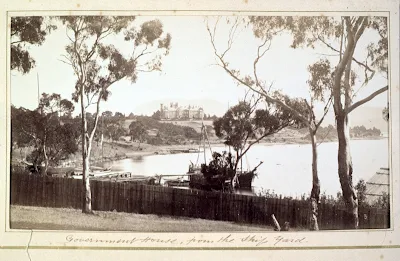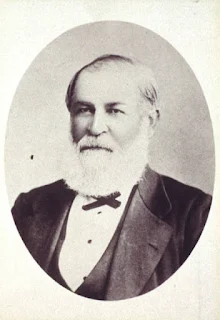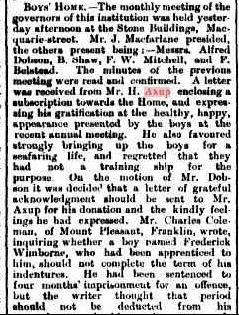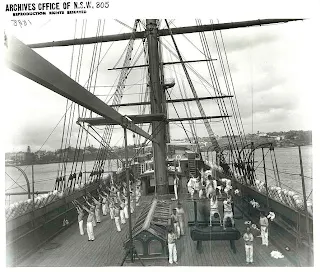McGREGOR brothers Alex, John, James and family
PATENT SLIP Queen's Domain Hobart
The patent slip at the Queen's Domain in Hobart was established by Elizabeth Rachel Nevin's uncle, Captain Edward Goldsmith, in 1854 from machinery he brought out from London on his finest trading barque The Rattler. He obtained a long lease on the foreshore of the Domain from Sir William Denison to lay the slip on the condition that the terms of the lease were fulfilled. When he withdrew from the lease in 1855 due to the sudden death from fever of his 25 yr old son Richard Sydney Goldsmith the previous year, among other reasons to do with costs and prison labor, Alexander McGregor bought Captain Goldsmith's interest.
Photographs of the Patent Slip 1870s

Title: New Government House [from the Patent Slip]
Creator: Clifford, Samuel, 1827-1890
Publisher: [ca. 1865]
Description: 1 stereoscopic pair of photographs : sepia toned ; 9 x 18 cm. (mount)
ADRI: AUTAS001125298653
Source: W.L. Crowther Library
Notes:Title printed on photographer's label on verso
NB: image is color corrected for display here in this article
Although the stereograph (above) bears Samuel Clifford's label on verso, it was probably taken by his younger partner Thomas Nevin in the early 1860s, as were many of the prodigious output of stereos printed and stamped by Clifford in the decade 1868-78. Clifford may have reprinted it after 1876 when he acquired Nevin's stock of commercial negatives while Nevin continued in civil service. Similar examples of Nevin's stereographs reprinted as a single image by Clifford or vice versa are of the Salmon Ponds, The Derwent River at Plenty, and other commercially viable and touristically appealing scenic representations. However, this stereograph and the single image below were taken at different times and from slightly different vantage points, and while purporting to represent Government House, in fact both images foreground the patent slip as the stronger signifier. Nevin certainly had an interest in the history of this slip because Captain Edward Goldsmith was Elizabeth Rachel Nevin's (his wife's) uncle. Note the figure of a man leaning against the tree near the fence in the stereograph which is missing in the single image, as is the second barque, but all other details are identical. The single image was taken at closer range, suggesting two photographers and two cameras, spending an afternoon at the slip. Note also that the single image does not bear Clifford's name nor any photographer's name, but is nonetheless attributed to Clifford by its inclusion in an album bearing his name.

Title: Government House from the Patent Slip
In: Tasmanian scenes P. 4, item 8
Publisher: [ca. 1865]
Description: 1 photograph : sepia toned ; 11 x 19 cm
Format: Photograph
ADRI: AUTAS001124074907
Source: W.L. Crowther Library
Notes: Title inscribed in ink below image ; date noted in pencil at lower right of image on album page ; item number noted in ink at centre left of image on album page
Exact size 105 x 184 mm
"Tasmanian scenes" also known as "Clifford album 1"
Another member of Thomas Nevin's cohort of photographers, Henry Hall Baily, took this photograph from the exact same spot a decade later, but labelled his photograph "Government House, from the Ship Yard", probably because he had no personal interest in the patent slip.

State Library of Tasmania
Title: Government House, from the Ship Yard
In: Baily album : Tasmanian souvenir P. 1
Publisher: [ca. 1875]
Description: 1 photograph : sepia toned ; 10 x 18 cm
Format: Photograph
ADRI: AUTAS001124850355
Source: W.L. Crowther Library
(NB: color corrected)
Captain Edward Goldsmith 1854-5

Notice of Captain Goldsmith's sale at the slip, Hobart Courier, 12th November 1855.
TRANSCRIPT
12th November 1855A brief history of the Patent Slip and other Hobart slips was published years later, in 1882 beginning with a tribute to Captain Goldsmith:
TO SHIPBUILDERS, CONTRACTORS, AND OTHERS
Unreserved Clearing Sale of the well selected and thoroughly seasoned Gum, Planking, Knees, Treenails, English Pine Spars, Yards, Cut Deals, Huon Pine in Logs; also Pitch, New Ten-ton Launch, Punts, &c, &c,, at the Yard of Captain Goldsmith, Government Domain.
To Captain Goldsmith, who came to the colonies in charge of one of the London traders, the credit of introducing patent slips into Hobart is due.
This is an excerpt from "Shipbuilding in Tasmania", a detailed account of this patent slip written with the benefit of 30 years hindsight, and printed in the Mercury Friday 23 June 1882. Read more at this link.
Read more on site about Captain Edward Goldsmith:
- Testimonial to Captain Edward Goldsmith 1849
- The Master Mariner in-laws: Captains Goldsmith, Day and Axup
- Hector Axup's donation to The Boys' Home for a ship 1887
The McGregor Family
Details of the transfer of the lease of the patent slip from Captain Goldsmith to Alexander McGregor from the Launceston Examiner, 21 January 1881, were outlined in an article looking back at ship building in Tasmania.
Source: Launceston Examiner, 21 January 1881
TRANSCRIPT
The twin steamer Kangaroo was built in the year 1854, under the immediate supervision of the late Governor Sir William Denison, R. E., by the late Captain Goldsmith, formerly of the London traders Waverley and John Izat, at the Imperial expenditure, regardless of cost. Her timbers, which (says the Mercury) are still as sound as ever, were the pick of the forests of Tasman's Peninsula, and her machinery was the best of the day. She was designed for the purpose she still serves, as a huge floating bridge between Hobart and Kangaroo Point, and was built on that portion of the Queen's Domain known as McGregor's patent slip. During the progress of her building a long lease of the site was granted to Captain Goldsmith by Sir William Denison, on condition that he laid down what was then much needed - a patent slip. The conditions of the lease were, however, unfulfilled by him, but the hon. Alexander McGregor purchased Captain Goldsmith's interest in the lease, and forthwith carried out its conditions by laying down the slip, now carried on by his brother, Mr. John McGregor, on the Queen's Domain.

Harriet McGregor at New Wharf with Wagoola
Format: photograph
Location: W.L. Crowther Library
ADRI: AUTAS001126070770
Source:W.L. Crowther Library
The Harriet McGregor, 332 tons, was built at the Domain shipyard by Alexander McGregor in 1871, and named after his wife, the former Harriet Bayley. It was the most renowned of the blue-gum clippers that made 24 voyages from Hobart to London and back as well as trading on intercolonial and Mauritian routes until sold in 1895 to Danish owners, renamed Water Queen, and destroyed soon after by fire at Rio.

'Lenna' Battery Point, Hobart - McGregor family on balcony for wedding
Item Number: PH30/1/7562
Start Date: 01 Jan 1860
Source: Archives Office of Tasmania

Wedding Party - Harriet McGregor (front left)
Description: photographic print
Date: 1860?
ADRI:PH30-1-7561
Source:Archives Office of Tasmania
The McGregor brothers - Alexander as merchant and ship owner, James as shipmaster and John as ship builder were one of the most successful mariners, shipbuilders and deep-sea whaling families in 19th century Tasmania, along with the Bayley brothers, Charles and James.

This photo is actually a John Watt Beattie reprint of an earlier photographer's work.
Title: Alexander McGregor
Creator(s): Beattie, J. W. 1859-1930
Date: 19--
Description: 1 photograph : sepia toning ; 14 x 10 cm.
Notes: Exact measurements 140 x 98 mm, Title inscribed in pencil beneath image in unknown hand., In: Members of the Parliaments of Tasmania - no. 187 / photographed by J.W. Beattie.
Location: Allport Library and Museum of Fine Arts
ADRI: AUTAS001125880799

Title: Alex McGregor
ADRI: PH30-1-6937
Source: Archives Office of Tasmania
The Domain Slipyard ca.1878, 1900 and 2014
Former site of Goldsmith's and McGregor's patent slip, now TasPorts Domain Slip

Title: Whaling ship "Velocity" at McGregors Slipyards 1878
TAHO Ref: ADRI: AUTAS001125641035

Title: Viking [at] McGregor's Shipyards, Domain - in background whalers Asia [and] Derwent Hunter?
Publisher:[Tasmania : s.n., ca. 1900]
Description:1 photographic print : sepia toned ; 16 x 21 cm
Format: Photograph
ADRI:AUTAS001126072040
Source: W.L. Crowther Library

Title: "Waterwitch" cutting at McGregor Slip 1890
ADRI: PH30-1-7500
Source: Archives Office of Tasmania

The Helen and Derwent Hunter at the Domain slip ca. 1900
TAHO Ref: NS1013177 (color corrected)

The Derwent Hunter at the Domain slip ca. 1900
TAHO Ref: NS1013174 (color corrected)

Above: the Kangaroo, built by Captain Goldsmith in 1854 on the Domain slip ca. 1900 (photo TAHO)
Below: the Ocean Dynasty on the Domain slip 2014 (photo © KLW NFC 2014)
Above: View towards Government House Hobart from the Domain slip 2014
Below: TasPorts Domain slip 2014
Photos © KLW NFC 2014
The Domain Slipyard, Hobart Tasmania 2014
Photos © KLW NFC 2014
RELATED ARTICLES main weblog

.jpg)




.jpg)










